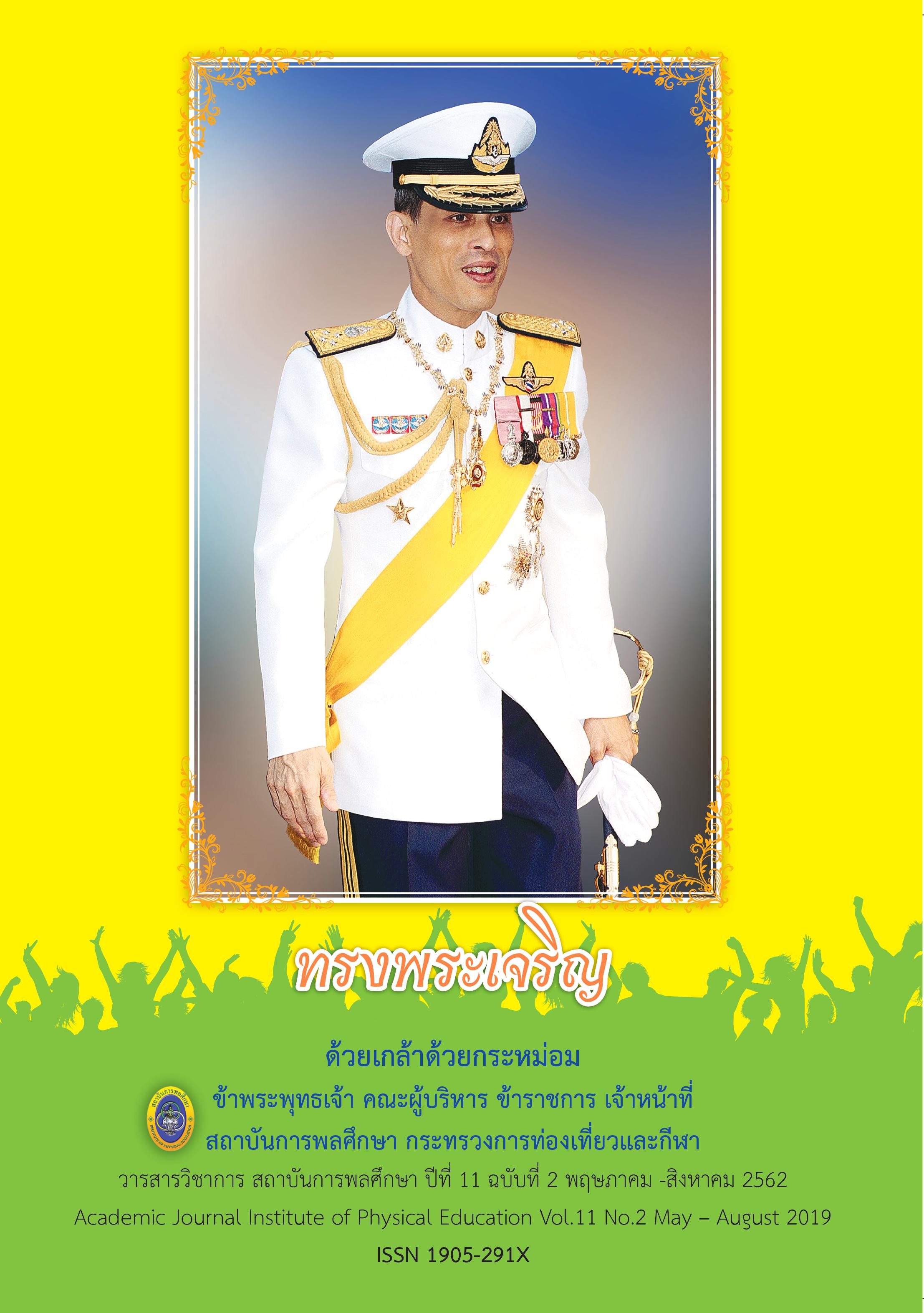การพัฒนาแบบวัดการรับรู้ภาวะติดการออกกำลังกายสำหรับคนไทย
Main Article Content
บทคัดย่อ
ปัจจุบันมีผู้สนใจศึกษาถึงผลที่เป็นอันตรายของการออกกำลังกายมากเกินปกติ หรือเรียกว่าภาวะเสพติดการออกกำลังกาย สำหรับประเทศไทยการศึกษาในประเด็นนี้ยังมีไม่มากนัก และยังไม่มีแบบวัดสำหรับคนไทยปรากฏให้เห็น การวิจัยครั้งนี้จึงมีวัตถุประสงค์เพื่อพัฒนาแบบวัดการรับรู้ภาวะติดการออกกำลังกายที่เหมาะสมสำหรับคนไทย โดยนำแบบวัดการรับรู้ภาวะติดการออกกำลังกาย (Exercise Addiction Inventory: EAI) ของ เทอรี่, ซาบู และกิฟฟิน (Terry, Szaboo, & Griffiths, 2004) ซึ่งมี 6 ข้อคำถาม มาพัฒนาเป็นฉบับภาษาไทย โดยใช้กระบวนการแปลกลับ (Back translation) และตรวจสอบความตรงเชิงเนื้อหาของแบบวัดการรับรู้ภาวะติดการออกกำลังกาย โดยผู้เชี่ยวชาญทางด้านจิตวิทยาการออกกำลังกายและการกีฬา และผู้เชี่ยวชาญทางภาษาอังกฤษ จากนั้นนำแบบวัด ฉบับภาษาไทยไปทดสอบกับกลุ่มที่ออกกำลังกายใกล้เคียงกับตัวอย่างจริง จำนวน 30 คน เพื่อตรวจสอบความเข้าใจเนื้อหาข้อคำถาม ผลการหาค่าความเที่ยงของแบบประเมินด้วยสัมประสิทธิ์แอลฟาของครอนบาค พบว่า มีค่า 0.75 ซึ่งตัวอย่างที่ใช้ในการศึกษาครั้งนี้เป็นประชาชนในจังหวัดสงขลา จำนวน 190 คน (ชาย 157 คนและ หญิง 33 คน) ที่มีอายุระหว่าง 20-70 ปี ที่ออกกำลังกายด้วยการปั่นจักรยาน เดินเร็ว และวิ่ง ตัวอย่างถูกเลือกแบบเจาะจง ทำการวิเคราะห์ความเที่ยงตรงเชิงโครงสร้างและวิเคราะห์องค์ประกอบเชิงยืนยันด้วยวิธี Confirmatory Factor Analysis (CFA) ผลการวิเคราะห์องค์ประกอบเชิงยืนยัน พบว่า โมเดลมีความสอดคล้องกับข้อมูลเชิงประจักษ์อยู่ในเกณฑ์ดี (c2= 12.24, df = 9, GFI = 0.97, AGFI = 0.95, CFI = 0.98, NNFI = 0.97, NFI = 0.95 และ RMSEA = 0.04) สรุปได้ว่า แบบวัดการรับรู้สภาวะติดการออกกำลังกายสำหรับคนไทย มีความตรงและความเที่ยงสามารถนำไปใช้เป็นเครื่องมือในการวัดการรับรู้ภาวะติดการออกกำลังกายได้
Article Details
บทความที่ได้รับการตีพิมพ์เป็นลิขสิทธิ์ของวารสารวิชาการ มหาวิทยาลัยการกีฬาแห่งชาติ ข้อความที่ปรากฏในบทความแต่ละเรื่องในวารสารวิชาการเล่มนี้ เป็นความคิดเห็นส่วนตัวของผู้เขียนแต่ละท่านไม่เกี่ยวข้องกับวารสารวิชาการมหาวิทยาลัยการกีฬาแห่งชาติ แต่อย่างใด ความรับผิดชอบองค์ประกอบทั้งหมดของบทความแต่ละเรื่องเป็นของผู้เขียนแต่ละท่าน หากมีความผิดพลาดใดๆ ผู้เขียนแต่ละท่านจะรับผิดชอบบทความของตนเองแต่ผู้เดียว
References
คมกริช ฐานิสโร. (2554). ออกกำลังกายเป็นอันตรายต่อสุขภาพ?. Business Way Thailand, 5, 42-43.
จิราพร เขียวอยู่. (2543). โครงการอบรมระยะสั้นและการประชุมเชิงปฏิบัติการประจำปี 2543 หลักสูตรการสร้างมาตรวัดสำหรับงานวิจัยทางวิทยาศาสตร์สุขภาพ. ขอนแก่น: ภาควิชาชีวสถิติและ ประชากรศาสตร์ คณะสาธารณสุขศาสตร์มหาวิทยาลัยขอนแก่น.
สุชาติ ประสิทธิ์รัฐสินธุ์. (2540). ระเบียบวิธีวิจัยทางสังคมศาสตร์. กรุงเทพฯ: โรงพิมพ์เลี่ยงเชียง.
สุวิมล ติรกานันท์. (2550). การสร้างเครื่องมือวัดตัวแปรในการวิจัยทางสังคมศาสตร์: แนวทางสู่การปฏิบัติ. กรุงเทพฯ: โรงพิมพ์แห่งจุฬาลงกรณ์มหาวิทยาลัย.
Ackard, D. M., & Neumark-Sztainer, D. (2002). Date violence and date rape among adolescents: Associations with disordered eating behaviors and psychological health. Child Abuse & Neglect, 26(5), 455-473.
Brislin, R.W. (1986). The wording and translation of research instruments. In W. Lonner & J. Berry (Eds.), Field methods in cross-cultural research, 137-164.
Griffiths, M. (2002). The educational benefits of videogames. Education and Health, 20(3), 47-51.
Griffiths, M. D., Szabo, A., & Terry, A. (2005). The Exercise Addiction Inventory: A quick and easy screening tool for health practitioners. British Journal of Sports Medicine, 39 (e30), 1-2.
Griffiths, M. D., Urban, R., Demetrovics, Z., Lichtenstein, M. B., de la Vega, R., Kun, B., & Szabo, A. (2015). A cross-cultural re-evaluation of the Exercise Addiction Inventory (EAI) in five countries. Sports Medicine-Open, 1(1), 1-7.
Ferketich S. (1990). Focus on psychometrics. Internal consistency estimates of reliability. Research Nurse Health.; 13(6):437-440.
Hausenblas, H. A., & Downs, D. S. (2002). How much is too much? The development and validation of the exercise dependence scale. Psychology and Health, 17(4), 387-404.
Johnson, M. (2000). Understanding Exercise Addiction. The Rosen Publishing Group.
Lichtenstein, M. B., Christiansen, E., Bilenberg, N., & Støving, R. K. (2014). Validation of the exercise addiction inventory in a Danish sport context. Scandinavian Journal of Medicine & Science in Sports, 24(2), 447-453.
Li F, Harmer P, Chi L. & Vongjaturapat, N. Cross-culture validation of the task and ego orientation in sport questionnaire. Journal of Sport & Exercise Psychology; 1996; 18: 392-407.
Monok, K., Berczik, K., Urban, R., Szabo, A., Griffiths, M. D., Farkas, J., … & Demetrovics, Z. (2012). Psychometric properties and concurrent validity of two exercise addiction measures: A population wide study. Psychology of Sport and Exercise, 13(6), 739-746.
Ogden, J., Veale, D., & Summers, Z. (1997). The development and validation of the Exercise Dependence Questionnaire. Addiction Research & Theory, 5(4), 343-355.
Pasman, L., & Thompson, J. K. (1988). Body image and eating disturbance in obligatory runners, obligatory weightlifters, and sedentary individuals. International Journal of Eating Disorders, 7(6), 759-769.
Sicilia, Á., Alías-García, A., Ferriz, R., & Moreno-Murcia, J. A. (2013). Spanish adaptation and validation of the Exercise Addiction Inventory (EAI). Psicothema, 25(3), 377-383.
Szabo, A., & Griffiths, M. (2007). Exercise addiction in British sport sciences students. Intertiational Journal of Mental Health and Addiction, 5, 25-28.
Szabo, A., De La Vega, R., Ruiz-Barquín, R., & Rivera, O. (2013). Exercise addiction in Spanish athletes: Investigation of the roles of gender, social context and level of involvement. Journal of Behavioral Addictions, 2(4), 249-252.
Schumacker, R. E., & Lomax, R. G. (2010). A Beginner’s Guide to Structural Equation Modeling. (3rd ed.). New York: Taylor and Francis Group.
Terry, A., Szabo, A., & Griffiths, M. (2004). The exercise addiction inventory: A new brief screening tool. Addiction Research and Theory, 12(5), 489-499.
Warner, R., & Griffiths, M. D. (2006). A qualitative thematic analysis of exercise addiction: An exploratory study. International Journal of Mental Health and Addiction, 4(1), 13-26.
Youngman, J., & Simpson, D. (2014). Risk for Exercise Addiction: A Comparison of Triathletes Training for Sprint-, Olympic-, Half-Ironman-, and Ironman-Distance Triathlons. Journal of Clinical Sport Psychology, 8(1), 19-37.

